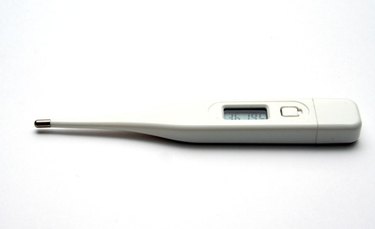
A normal human body temperature should measure 98.6 F, according to Medline Plus, a service of the National Library of Medicine. Medline Plus also states a normal pulse should be 60 to 100 beats per minute for adults. Each beat of the human heart circulates blood through the vessels, carrying oxygen and nutrients to the rest of the body. This circulatory system is also responsible for temperature control throughout the body. Blood pressure could be considered the body's heating and cooling system.
Blood Pressure
Video of the Day
The human body uses homeostasis to regulate itself internally, despite whatever activity the person is engaged in or environmental issues he is encountering. Blood pressure regulation is part of homeostasis. A normal blood pressure should be approximately 120 over 80, according to Creighton University Medical Center. Depending on the outside temperature, blood vessels will either dilate or contract. A dilation of the blood vessels will cause a drop in blood pressure, and this lowers body temperature. Contracting vessels increase blood pressure, resulting in increasing core temperature.
Video of the Day
Maintaining Temperature
A person's internal body temperature increases when he exercises, or if he has a fever. Normally a person perspires to cool off. This causes him to lose fluid and become dehydrated. As a result, the body has to come up with another way to cool off, so the blood vessels dilate. This lowers the pressure within the veins, allowing the blood to cool.
Heart Rate
Blood pressure is a measurement of the force applied to the inside walls of blood vessels. The pressure is a result of the amount of blood being pumped and the width of the blood vessels themselves. When blood vessels dilate as a response to increased body temperatures, the heart has to pump faster to maintain blood pressure.